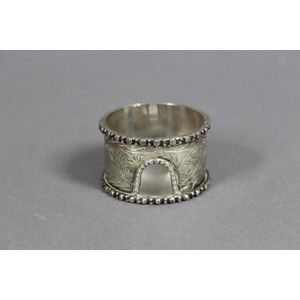Russian Silver Elephant Bibelot with Green Enamel and Garnet Eyes
Russian silver and green guilloche enamel elephant Bibelot, on a circular footed base decorated with a cast frieze of fruiting grape vine applied over a green guilloche enamel ground, stylized head inset with cabochon garnet eyes, marked in Cyrillic K.F, Imperial warrant, 84 silver standard, height 7.3 cm
You must be a subscriber, and be logged in to view price and dealer details.
Subscribe Now to view actual auction price for this item
When you subscribe, you have the option of setting the currency in which to display prices to $Au, $US, $NZ or Stg.
This item has been sold, and the description, image and price are for reference purposes only.
- Frieze - An architectural term denoting the flat, shaped or convex horizontal surface of furniture, between the architrave and the cornice, usually found on a cabinet or bookcase, or on desks and tables where it may include drawers, the area between the top and the legs. In ceramics, the term refers to the banding, of usually a repeating pattern, on the rims of plates and vases.
- Garnet - A garnet is a mineral that is commonly used as a gemstone. It occurs in a wide range of colours, including red, pink, orange, green, yellow, and black. The most common and best known type of garnet is the red variety, which has a deep, rich colour and is often referred to as a "garnet red."
Garnets have a long history of use as gemstones, and they have been prized for their beauty and durability for thousands of years. They are often used in jewellery, such as rings, necklaces, and earrings, and they are also sometimes used as a decorative element in other items, such as vases and goblets.
Garnets are prized for their brilliance, durability, and resistance to scratching, making them a popular choice for use in jewellery. They are also valued for their hardness, which makes them well suited for use in abrasive applications, such as sandpaper and grinding wheels. - Guilloche - A form of classical decoration consisting of a repeating ornament of interlacing curved bands, sometimes forming circles, and further decorated with rosettes or other flower forms.
The name is derived from the inventor, French engineer Guillot, who invented a mechanical method of inscribing fine repeating patterns on to metallic surfaces.
On enamelled items with guilloche decoration, the surface is firstly engraved with the repeating pattern, and then covered with several layers of enamel, each of which is fired.
Where the item has not been enamelled the form of decoration is usually called "engine turned".
This item has been included into following indexes:
Visually similar items

Silver napkin ring marked in Arabic script, 40g
Sold by
in
for
You can display prices in $Au, $US, $NZ or Stg.

A Spode cylindrical vase pattern 1166, with painted reserves on deep blue ground with gilt, with moulded beaded edge, underglaze red Spode mark 10 cm high
Sold by
in
for
You can display prices in $Au, $US, $NZ or Stg.

A sterling silver perfume bottle holder. 18 cm high.
Sold by
in
for
You can display prices in $Au, $US, $NZ or Stg.

A 15ct gold thimble; guilloche and engraved pattern hallmarked Chester 1926. Wt. 6.2g.
Sold by
in
for
You can display prices in $Au, $US, $NZ or Stg.
